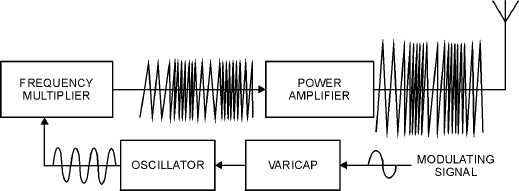2-5
Figure 2-4.—Fm transmitter block diagram.
Harmonics
True harmonics are always exact multiples of the basic or fundamental frequency generated by an
oscillator and are created in amplifiers and their associated circuits. Even harmonics are 2, 4, 6, and so on,
times the fundamental; odd harmonics are 3, 5, 7, and so on, times the fundamental. If an oscillator has a
fundamental frequency of 2,500 kilohertz, the harmonically related frequencies are
5,000………………second harmonic
7,500………………third harmonic
10,000………………fourth harmonic
12,500………………fifth harmonic
You should note that the basic frequency and the first harmonic are one and the same.
The series ascends indefinitely until the intensity is too weak to be detected. In general, the energy in
frequencies above the third harmonic is too weak to be significant.
In some electronics books, and later in this chapter, you will find the term SUBHARMONIC used. It
refers to a sine wave quantity (for example, an oscillator output) that has a frequency that is a submultiple
of the frequency of some other sine wave quantity it helped make. For example, a wave that is half the
fundamental frequency of another wave is called the second subharmonic of that wave; one with a third of
the fundamental frequency is called a third subharmonic; and so forth.
Q4. What purpose does a microphone perform in an AM transmitter?
Q5. In an fm transmitter, when does an oscillator generate only a steady frequency?
Q6. What is a harmonic?
Q7. If the fundamental frequency is 200 megahertz, what is the third harmonic?

